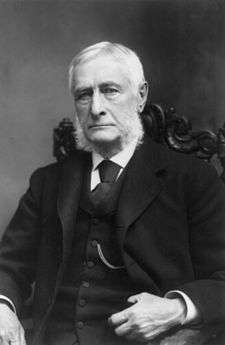John Edward Parsons
| John Edward Parsons | |
|---|---|
 Parsons, c. 1910 | |
| President of the New York City Bar Association | |
|
In office 1900-1901 | |
| Preceded by | James C. Carter |
| Succeeded by | William Gardner Choate |
| Personal details | |
| Born |
October 24, 1829 New York City, New York, U.S. |
| Died |
February 16, 1915 (aged 85) New York City, New York, U.S. |
| Spouse(s) |
Mary D. McIlvaine Florence V. C. Bishop |
| Children | Herbert Parsons |
| Parents |
Edward Lamb Matilda Parsons |
| Education | New York University |
John Edward Parsons (October 24, 1829 – January 16, 1915) was a lawyer in New York City. He was president of the New York City Bar Association from 1900 to 1901.
Early life
Parsons was born in New York City in 1829 to Edward Lamb and Matilda Parsons. His father was English and his mother was descended from a prominent Wallingford, Connecticut family.
He was educated at New York University, where he earned a B.A. in 1848 and an M.A. in 1851. He also received an honorary M.A. from Yale Law School.[1] and was admitted to the bar in 1851 or 1852.[2]
Career
Parsons began his legal career as the New York County Assistant District Attorney, where he managed many of the city's prosecutions. This would be the only public position he would hold in his career.[2] He was a founding member, and later president, of the New York City Bar Association and played an important role in the Bar's prosecution of corrupt judges Albert Cardozo, John McCunn, D.P. Ingraham, and George Barnard. Later in his career, he started several practices, ultimately founding the firm Parsons, Closson & McIlvaine in 1902.
His largest client was the American Sugar Refining Company, the precursor to the Domino Sugar company. In United States v. E. C. Knight Co., Parsons successfully defended American Sugar Refining from an anti-trust suit by the United States government, preserving its over $90 million in assets.[3] In 1900, Parsons – who had said about trusts "I believe in trusts. They are economic necessities calculated to benefit the public"[2] – was indicted by a Federal Grand Jury in Washington, D.C. for restraint of trade in trying to monopolize the sugar industry. The case did not go to trial until 1912, and a jury could not reach a unanimous decision.[2]
Social life and philanthropy
Parsons was a member of the board of a number of New York cultural institutions, including the American Museum of Natural History and the Metropolitan Museum of Art. He served as a member of the Council of New York University, appointed in 1867, and for several years president of the NYU Alumni Association.[2] He served as President of Cooper Union from 1905 to 1915.[4]
He was also a member of a number of gentlemen's clubs, including the University Club of New York, the Century Club, the Players Club and the Metropolitan Club, among others.[1][2]
Personal life
He was married twice, first to Mary Dumesnil McIlvaine (1834–1896). His children by his first wife included:
- Edith Parsons (1865–1942), who married Dr. D. Percy Morgan.
- Herbert Parsons (1869–1925), a New York politician who married Elsie Worthington Clews (1875–1941), a daughter of financier and author Henry Clews.[2]
After her death, he was married to Florence Van Corltandt (née Field) Bishop (1851–1922),[5] the widow of David Wolfe Bishop, parents of Cortlandt F. Bishop, the pioneer aviator.[6]
Parsons had a summer estate called "Stoneover" in Lenox, Massachusetts,[1] and was a member of both the Brick Presbyterian Church in New York and the Protestant Episcopal Church in Lenox,[1]
Parsons died at his residence in New York City, 30 East 36th Street, on January 16, 1915. His will gave all his money to his wife and children, and decried what he called "posthumous charity."[7]
References
- Notes
- 1 2 3 4 "Parsons, John Edward" The New York Genealogical and Biographical Record, Vol. XLVII, (1916)
- 1 2 3 4 5 6 7 "John E. Parsons, Noted Lawyer, Dead" New York Times (January 17, 1915)
- ↑ United States v. E. C. Knight Company, 156 U.S. 1, 15 S.Ct 249 (1895)
- ↑ Cooper Union Annual Reports, 1905-1915
- ↑ Times, Special To The New York (16 October 1922). "MRS. PARSONS DIES AT HER COUNTRY HOME; Widow of Noted Lawyer Passes Away After Several Weeks Illness in Pittsfield". The New York Times. Retrieved 3 May 2017.
- ↑ York, Saint Nicholas Society of the City of New (1905). The Saint Nicholas Society of the City of New York: History, Customs, Record of Events, Constitution, Certain Genealogies, and Other Matters of Interest. V. 1-. The Saint Nicholas Society of the City of New York. Retrieved 3 May 2017.
- ↑ "Parsons Millions All Go to Family" New York Times (January 29, 1915)
- Bibliography
- Dumas Malone (ed.) "John Edward Parsons." Dictionary of American Biography, Vol. XIV. New York, NY: Charles Scribner's Sons, 1934.